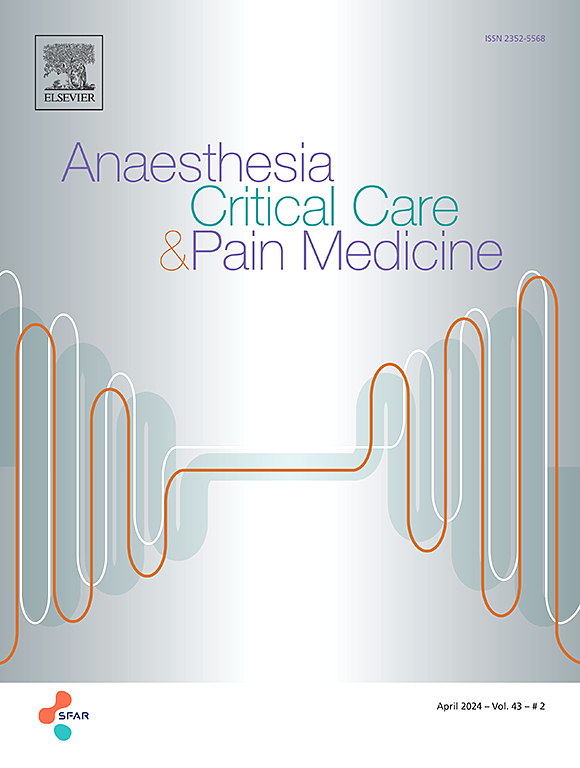重症监护中获得的代谢性碱中毒:一项回顾性队列研究。
IF 4.7
3区 医学
Q1 ANESTHESIOLOGY
引用次数: 0
摘要
简介:碱中毒是重症监护病房(ICU)患者常见的酸碱失调。我们评估了在ICU住院期间发生的代谢性碱中毒的流行病学及其与预后的关系。方法:对2015年1月1日至2021年12月31日澳大利亚昆士兰州12例icu入院患者进行多中心回顾性队列研究。我们排除了再入院、前24小时内代谢性碱中毒患者和ICU住院时间(LOS)≤48小时的患者。主要结局是入院期间代谢性碱中毒的累积发生率,次要结局是潜在潜在原因的发生频率。多变量分析,包括不朽时间偏差的调整,用于探索其与死亡率的关系。结果:24,676例符合条件的住院患者中,8,889例(36%)在ICU住院期间发生代谢性碱中毒。在ICU中至首次发病的中位时间为4天(四分位数范围为3-6天)。最常见的潜在原因是利尿剂(28%)和类固醇(24%),但超过40%的病例无法确定原因。在对不朽时间偏差进行调整后,代谢性碱中毒患者的死亡率增加。然而,在使用多变量分析调整疾病严重程度和合并症后,它不是结果的独立预测因子。结论:代谢性碱中毒常见于ICU,但其与死亡率升高的关联可能归因于其他混杂因素。需要进一步的研究来阐明其潜在的原因,以及纠正碱中毒的治疗是否能改善结果。本文章由计算机程序翻译,如有差异,请以英文原文为准。
Metabolic alkalosis acquired in intensive care: A retrospective cohort study
Introduction
Alkalosis is a common acid-base disturbance in intensive care unit (ICU) patients. We evaluated the epidemiology of metabolic alkalosis developing during admission to the ICU and its relationship with outcome.
Methods
Multicentre, retrospective cohort study of admissions to 12 ICUs in Queensland, Australia from January 1st, 2015 to December 31st, 2021. We excluded readmissions, patients with metabolic alkalosis within the first 24 h and those with ICU length of stay (LOS) ≤48 h. The primary outcome was the cumulative incidence of metabolic alkalosis during admission, and secondary outcomes were the frequency of potential underlying causes. Multivariable analyses, including adjustment for immortal time bias, were used to explore its relationship with mortality.
Results
Of 24,676 eligible admissions, 8889 (36%) developed metabolic alkalosis during their stay in the ICU. The median time to first development was four days in the ICU (interquartile range 3–6 days). The most common potential causes were diuretics (28%) and steroids (24%), but no cause could be identified in more than 40% of cases. After adjustment for immortal time bias, patients with metabolic alkalosis were seen to have increased mortality rates. However, it was not an independent predictor of outcome after adjusting for disease severity and comorbidities using multivariable analysis.
Conclusion
Metabolic alkalosis develops commonly in the ICU, but its association with increased mortality may be attributable to other confounding factors. Further research is required to elucidate its underlying causes and whether treatments to correct alkalosis improve outcomes.
求助全文
通过发布文献求助,成功后即可免费获取论文全文。
去求助
来源期刊

Anaesthesia Critical Care & Pain Medicine
ANESTHESIOLOGY-
CiteScore
6.70
自引率
5.50%
发文量
150
审稿时长
18 days
期刊介绍:
Anaesthesia, Critical Care & Pain Medicine (formerly Annales Françaises d''Anesthésie et de Réanimation) publishes in English the highest quality original material, both scientific and clinical, on all aspects of anaesthesia, critical care & pain medicine.
 求助内容:
求助内容: 应助结果提醒方式:
应助结果提醒方式:


